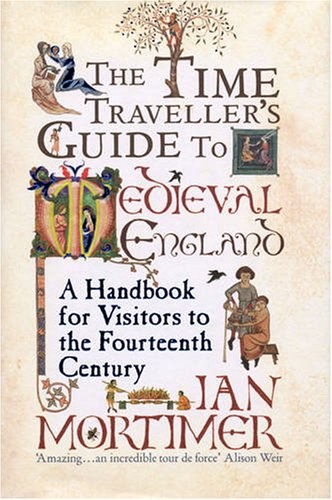Wouldn’t it be wonderful to have your very own time machine like the time travelling car from the movie Back to the Future?
Months ago, I found myself lost in a riveting history book entitled, The Time Traveller’s Guide to Medieval England, which led to my dreaming of bending the rules of time and space.
Besides herculean attempts to ward off the bubonic plague, what would you do if you landed back in time to the Middle Ages? You might knock on John Wycliffe’s door and ask him about the intricacies of translating the Bible into the English language, or spy on Johannes Gutenberg inventing the moveable printing press.
You might even try your hand at the tasks a peasant would do, like ploughing a cornfield, or threshing and winnowing grain, or plastering walls of a house with a mixture of straw, mud and manure (ewwwh).
How would you occupy your free time?
Watch a play
There’s nothing quite like watching a live performance. In live theatre, there are no second chances. When mistakes are made, actors must improvise and adapt to rescue the situation.
We as the audience in our comfortable seats, cringe with second hand embarrassment as the actors fumble and attempt to recall forgotten lines.
However, great theatre actors know how to play off the crowd’s energy. This collective verve assumes a life of its own. It thrums with a pulse. It crackles with electricity. It swells and recedes with every exchange between the performers and audience.
Like clay, our perception yields, even longs to be manipulated in our suspension of disbelief. And all that energy will inevitably heighten our senses and emotions.
The performer’s blunder is soon forgiven with a witty comment, an adlibbed line that wins us over. And we are awash in a sea of laughter and surprise.
Present day audiences rush to buy tickets to see popular actors or perform live, how much more would medieval folk gather for a play?
During the Middle ages, people would flock to see a drama about God, or Christ or His saints. Religious plays were all the rage. Familiar biblical stories were a source of fascination, comfort and affirmation.
Who would not weep with gratitude for the reenactment of Jesus’ agony on the cross for all humankind? Or repent of sins after watching the drama unfold of Noah and the flood destroying the wicked?
Certainly, these plays enriched and elevated the lives of the audience, giving meaning to an otherwise harsh existence.

Set forth on a religious tour
Another pastime involved going on a religious pilgrimage to visit a shrine or relic. Such an adventure would take weeks or even months on foot.
According to the Oxford dictionary, a shrine is a place regarded as holy due to its associations with a divinity or a sacred person or relic, marked by a building or other construction.
Relics are the material remains, such as bones, hair and teeth of a dead saint or martyr that are kept as items of reverence.
Note that even the clothing worn by a deceased saint may be considered relics because they are objects that have come into contact with a relic and therefore, also considered relics.
Why visit a shrine or relic?
There were many reasons for embarking on a religious pilgrimage. Some would have struck a bargain with God.
Victors in battle who experienced the protective hand of God might go on a pilgrimage to give thanks. Whereas, others might leave on foot in search of excitement and adventure.
It was wise not to embark on a pilgrimage on your own. Cunning thieves laid traps for the unsuspecting traveller, and seasoned thugs could also do more than just rough up their victims.
Surrounding yourself in the company of fellow pilgrims meant sharing meals, stories, songs and experiences, while also offering some measure of physical protection.
In the middle ages, you might set off on a pilgrimage to view the head of John the Baptist. But where would you go? What if three churches claimed to possess the head of this famous prophet?
If the claims were true, then John the Baptist was a freak—a three headed monster, astutely pointed out by Ian Mortimer, author of The Time Traveller’s Guide to Medieval England.
It is laughable, but I’m sure there were plenty of inauthentic relics circulating back then as there are in the present day. Chaucer, the famous medieval poet, wrote of the use of pig bones in place of a martyr’s remains.
A pilgrimage to the Canterbury Cathedral in Medieval England would allow you see the shrine of St. Thomas Becket, archbishop of Canterbury.
If healing is what you sought, you could purchase a small amount of holy water mixed with his own diluted blood. This water, sold in lead and pewter flasks, was said to possess spiritual and medicinal properties.
Some of the relics you may visit today
St. Paul’s chains at San Paolo Fuori Le Mura. Apparently, these chains bound the apostle Paul before his martyrdom.
In Rome, at the Basilica of the Holy Cross you can view Doubting Thomas’ finger. Possibly the one that touched the resurrected Christ and his wounds.
If you’re interested in Jesus’ crown of thorns, then head off to Paris, France. The crown is said to be in the Cathedral of Notre Dame.

Why do some people venerate the relics of the saints? Is there biblical support?
The New Testament describes pieces of cloth used for the healing of the sick and the exorcising of demons.
And God wrought special miracles by the hands of Paul: So that from his body were brought unto the sick handkerchiefs or aprons, and the diseases departed from them, and the evil spirits went out of them. Acts 19:11,12
Life giving Bones (and I’m not talking about bone marrow transplants)
The Old Testament records a remarkable incident concerning the remains of the great prophet Elisha.
And Elisha died, and they buried him. And the bands of the Moabites invaded the land at the coming in of the year.
And it came to pass, as they were burying a man, that, behold, they spied a band of men; and they cast the man into the sepulcher of Elisha: and when the man was let down, and touched the bones of Elisha, he revived, and stood up on his feet. 2 Kings 13:20-21
When I read this account, it helped me to understand why some people would revere the remains of a prophet or saint.
The main argument against the veneration of relics is their doubtful authenticity. Are the remains or the objects fair dinkum or are they frauds?
In addition, the veneration and worship of relics may lead to superstitious practices and idolatry. If you came into possession of an actual piece of wood from the cross that bore Christ’s body, the temptation would be that you’d use it to ward off evil. You might even attempt to exorcise demons with it or heal the sick.
There would be the danger of worshipping the relic rather than worshipping the one true God.
I’m not in possession of any relics, but I know that sometimes my heart can be led astray in the worship of modern day idols.
I don’t bow down to physical idols made of stone or wood, but I can give too much attention to other things or people more than God.
Randy Alcorn states the problem well, ‘An idol is anything we praise, celebrate, fixate on, and look to for help that’s not the true God.’ Alcorn (2015,67)
I’d like to explore the significance of the bones of Elisha and their power to resurrect a dead man in more detail. So look out for Part 2 in the weeks to come.
In the meantime,
Wherefore, my dearly beloved, flee from idolatry. 1 Corinthians 10:41
Bibliography
Author unspecified. 2015, (updated 31 January 2021), ‘Relics in Christianity’, Religion Facts. Retrieved 25 February 2022 from
https://religionfacts.com/christianity/relics
Alcorn, R. 2015, Happiness, Tyndale House Publishers, Illinois.
Blankespoor, J. 1984, ‘2 Kings 13:21 The speech of Elisha’s grave’, Christian Library. Retrieved 25 February 2022 from
https://www.christianstudylibrary.org/article/2-kings-1321-speech-elishas-grave
Deffinbaugh, B. 2004, ‘The Life and Time of Elisha the Prophet’, Bible.org. Retrieved 25 February 2022 from
Guzik, D. 2019, ‘Life from a Tomb’, Enduring Word. Retrieved 25 February 2022 from
Life from a Tomb
Mortimer, I. 2009, The Time Traveller’s Guide to Medieval England, Vintage Books, London.
Mettler, L. 2015, ‘Most Fascinating Christian Relics Around the World’, 10 Best. Com. Retrieved February 2022 from
https://www.10best.com/interests/explore/most-fascinating-christian-relics-around-the-world/
Oxford dictionary online


